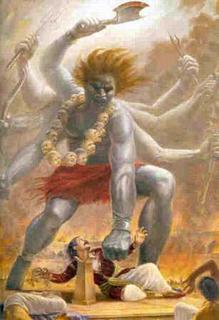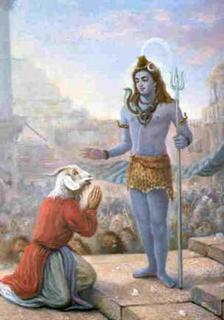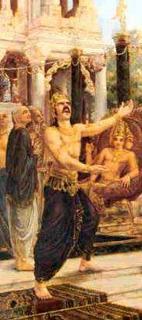Shiva had married twice.
His love for his first wife, Sati is a tragedy that has resulted in the construction of Shakti Peeths all over India. His second wife was Shakti incarnate again as Parvati.
Daksha, the prajapati, was the master of civilisation. He formulated the rules of society and ensured the survival of the traditional order. His daughters were wives of the gods and their children had gone on to populate the whole world.
His youngest child, Sati, was someone very special, a manifestation of the mother-goddess herself.
Shiva was Ekavratya, an unorthodox hermit, who lived by his own rules, not always acceptable to traditional society. He refused to conform to the ways of the world.
As guardian of civilisation, Daksha found that subversive. Shiva wandered in cremation grounds with a rowdy bunch of renegades consuming intoxicants that are forbidden in decent society. He sings and dances wherever he wants to, with little heed to decorum and protocol. He has no home, no possessions, no family, no vocation; he is a drifter, ritually impure, unsuitable for any of my daughters, especially Sati.
Shiva refused to indulge Daksha's ego. Daksha made the laws, defined codes of conduct, formulated the rules of society. He considered himself to be someone special. He expected reverance. Shiva refused to indulge in any social rules that promoted pomposity in the name of respect.
This legend is associated with the destruction of Daksha's sacrifice and the origin of the Shakti Peethas of India. This is one of the eight legends portraying Shiva as the destroyer of evil.
Sati, the consort of Shiva was the daughter of Daksha Prajaapati a descendant of Bhrama.
Sati did have a hard time to persuade Shiva to marry her.
"I have renounced the world, how can I marry her,"cried Shiva.
He could not ignore the intensity of Sati's love for him. I have nothing to offer. I have neither property nor a lineage, nor do I desire any. I only observe society; I do not participate in it Shiva told her.
Sati said "because you are incomplete without me and I am incomplete without you. I do not ask for anything, but you. I accept you for what you are, not for what you have..I would like to observe with you."
Sati followed Shiva wherever he went, over hills, across desolate plains and dense forests, through cremation grounds. Shiva at first ignored Sati. He barely acknowledged her.
She followed him selflessly, content to be by his side. Her fortitude and patience, her serene determination to be his consort, her giving nature and radiant personality everything about her pleased Shiva.
Daksha meanwhile organised a great yagna. All the gods were invited except Shiva as he meant to insult Shiva. Shiva was offended. Inspite of Shiva's admonitation Sati willfully went for the yagna.
Her father insultingly said "you were not invited. Are you fed up with your vagabon husband."
Sati stood up for her husband. "He is a true yogi, he has no attachment to the false ways of the world and society. He is one with nature and the plants and beasts".
Daksha was so enraged with Shiva. He had forgotton that Sati was his beloved daughter. Daksha called Shiva a uncouth beast. Sati wept with humiliation. The humiliation was hard to bear . She sat on the ground ,controlled her breath and stoked her inner fire and self immoluted her self .
News of Sati's death shocked Shiva. Shiva experienced the pangs of separation, viraha, the anguish of loneliness. From that suffering, came anger. With the anger came the monsters of fever. Shiva became Jvareshva, lord of fevers. His indignation contorted his features and turned him into the savage Virupaksha, the malignant-eyed

Shiva plucked out his hair and lashed it on the ground to create the grim Virabhadra and the fierce Bhadrakali.
"Go ravish the sacrifice - violate the fire, poison the waters, pollute the air and kill the gods.
They deprived me of Sati, let them be deprived of their lives," ordered Shiva.
Virabhadra picked up his trident and summoned an army, a cackling horde of ghosts, goblins, ghouls, genii, monsters, demons, dragons, freaks, fiends and spirits - the ganas of Shiva.
They marched towards Daksha's sacrificial halls cheered by the shrill cries of Bhadrakali.Evil omens had begun to appear at Daksha's palace. Vultures circled above the sacrificial altar, wolves howled.
Fear arose in the very heart of the cosmos. A hundred thousand rabid dogs rushed into Daksha's precinct carrying on their backs the monsters of fever. These fiends leapt on the gods and struck them with such fury that they all began to convulse .
Virabhadra and his savage entourage descended on the scene. They wrecked the place sacred vessels were kicked, tapesteries were ripped and pavilions burnt. As the gods took flight, the demons seized and massacred them all. Bhadrakali drank their blood.

The sage Bhrigu used his magical powers and tried to conjure up spirits who would save the yagna. But the spirits refused to emerge when they heard Bhadrakali howl. Those that did were dismembered by Shiva's ganas. Finally Bhadrakali dragged Daksha by his feet towards the fire-altar.
Virabhadra raised his axe and beheaded the prajapati.
The severed head was tossed into the flames.The sacrificial hall was now claimed by Shiva. He became known as Hara,the ravisher. Finally Shiva's fury subsided. Only the sorrow remained.
Shiva walked into Daksha's sacrificial hall and was confronted with the aftermath of the bloodbath. He was filled with pity. The survivors of the carnage fell at his feet and begged for mercy.
He smiled. Instantly a fragrant breeze swept across the scene. The fevers subsided. The dead gods arose as if waking from a deep slumber. Their wounds had healed, the broken bones had been mended, the missing limbs restored.
Shiva found Daksha's headless body and brought it back to life, replacing his head with that of a goat. Shiva then gave him the city of Bhogya. This is a city of uninhibited pleasure."I created it for Sati. Here I indulged in every pleasure imaginable and became a bhogi. But now Sati is no more. I have no use for Bhogya. I gift it to you."The goat-headed prajapati began to sing Shiva's praises. You are Shankar, the benevolent one, the God of Gods.
Shiva picked up Sati's lifeless body. He could not bring himself to cremate it. The body was all that he had to remind him Distraught, he wandered across the cosmos with Sati's corpse in his arms,with tears in eyes .S
hiva could not be consoled .His mournful cry rent the galaxies and stunned the gods. This must stop, said Brahma, Otherwise the whole cosmos will be submerged by Shiva's agony.
Vishnu raised his finger to spin his mighty discus, sudarshan chakra, and let it fly. Its sharp edges ripped Sati's corpse into 108 pieces. These fell in different parts of Earth, and became shaktipithas, the shrines of Sati. With the body gone, there was nothing left to remind Shiva of Sati, except memories. And memories fade.
Sati had taught Shiva all about pleasure. Her departure had taught him about anger. Together kama-krodha trap man in samsara. Shiva had had enough of life. He isolated himself in the icy caves of the Himalayas. He became a recluse once more. The mother-goddess, embodiment of all matter, is never stable. She is constantly in a state of flux. Her death was a transformation. Sati would return in another form, the form of Parvati.
An image of Dakshaaari Murthy, the slayer of Daksha is enshrined at Tiruppariyalur near Thanjavur. The Veeratteswarar temple here is one of the 8 Veerata stalas celebrating Shiva as the destroyer of evil forces.





1 comment:
Hari OM!!!
Awesome, Very beautifully narrated, Really took me a to very nice drive around Lord Shiva's "Special"---...thank you very much, will look forward for future bloggs.
Post a Comment